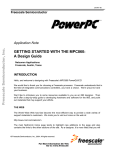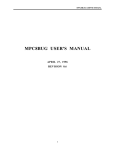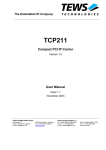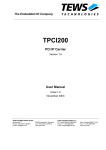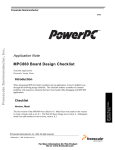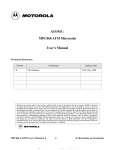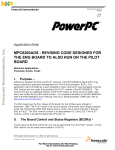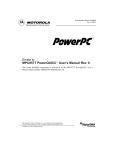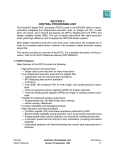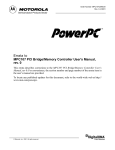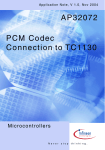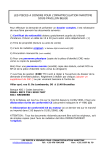Download Example Software for the MPC860 Demonstrating Initialization
Transcript
05/98 ™ Application Note Example Software for the MPC860 Demonstrating Initialization Netcomm Applications Motorola, Austin, Texas This document explains one approach to initializing the MPC860. It is designed to explain the process of how software begins execution from a power-up condition. It also includes the start of a debug port utilizing SMC2. It is important to note that this document is written from a software engineer’s point of view, so the hardware reset process, when mentioned, is discussed only to clarify the software initialization process. One common configuration was chosen for this example. It is left up to the reader to apply this example to a particular design. Most of the technical details are described in the form of in-line documentation embedded in the initialization source file. This document will only provide a high-level overview with more discussion in some areas that need further clarification. With this initialization example, a developer can integrate one of the available CPM-related software examples to form a starting platform. Integrating these software components and using them in conjuction with Motorola’s MPC860 ADS hardware testing platform will allow a software developer to begin the development phase before actual target hardware is available. The PowerPC name, and the PowerPC logotype are trademarks of International Business Machines Corporation, used by Motorola under license from International Business Machines Corporation. This document contains information on a new product under development by Motorola and IBM. Motorola and IBM reserve the right to change or discontinue this product without notice. © Motorola Inc., 1998. All rights reserved. Example Software for MPC860 Initialization Application Note Introduction Software Overview The areas requiring initialization on the MPC860 are as follows: • PowerPC core registers • Memory Management Unit (MMU) • Instruction and Data Cache • Clock circuitry • System PLL (SPLL) • Timers and Counters • System Interface Unit (SIU) • User Program Machines (UPMA) • Chip Select Machine • UPM Tables • Baud Rate Generator 2 • SMC2 No programming order is implied here. To learn the approach taken in this example, refer to the included source code. This software was designed to work with the MPC860 ADS board and functions similar to Motorola’s MPC8BUG debugger software initialization. The PowerPC core system clock, as well as the external bus frequency was chosen to be 24 MHz. This clock is derived from a 4 MHz crystal oscillator fed to the EXTCLK pin of the MPC860. The Hard Reset Configuration Word as well as MODCK1 and MODCK2 are defined by the BCSRs (Board Control and Status Registers located on the target) and is read on reset. SMC2 was initialized to perform echo capability to Port B (PB3), the RS232 port. This means an ASCII terminal can be connected and characters typed will be returned to the terminal at 9600 baud. The reasons for this function are two-fold. A way was needed to test the success of initialization, and it’s a useful function for a developer who wants to develop a debug port. The Ethernet LED on the 860ADS board blinks to give a simple visual indication that initialization was complete and code is executing in the main loop. References It is important that users familiarize themselves with the following references for a better understanding of the terminology and general MPC860 programming model. • MPC860 PowerQUICC™ User’s Manual; MPC860UM/AD • PowerPC™ Microprocessor Family: The Programming Environments for 32-Bit Microprocessors; MPCFPE32B/AD, Rev. 1 Memory Map Definition The memory map established during initialization is shown in Figure 1. This memory map includes areas for 4 Mbytes of DRAM, 16 Kbytes of BCSR (Board Control and Status Registers) space, 32 Kbytes for internal memory map registers/dual-port RAM, and 2 Mbytes (512K x 32) of FLASH memory. Chip Select 0 (CS0) is configured for Flash memory, CS1 for Board Control Status Registers (BCSR) and CS2 is used for DRAM. Bank Register 0 (BR0) and Option Register 0 (OR0) are used to define the address 2 Example Software for the MPC860 Demonstrating Initialization MOTOROLA space for the Flash. BR1/OR1 contain the BCSR address space definitions and BR2/OR2 define the DRAM address space. The BCSRs discussed above are 4 programmable logic parts that reside on the ADS board. The Board Control and Status Registers consist of the BCSR0, BCSR1, BCSR2, and BCSR3 and descriptions of these parts and their functions can be found in the MPC860 ADS manual included with the MPC860 ADS board. They provide special configurability options for the ADS. 0x00000000 EXCEPTION VECTOR TABLE 0x00002000 PROGRAM STACK AND DATA 4 MBYTE DRAM SPACE 0x00002800 DRAM 0x003FFFFF EMPTY SPACE 0x02100000 0x02104000 BCSR (BOARD CONTROL AND STATUS REGISTER EMPTY SPACE 0x02800000 FLASH (512K X 32) BYTES Initialization code is located at the start of flash space 0x02A00000 0xFF000000 EMPTY SPACE INTERNAL REGISTERS DUAL-PORT RAM 0xFF004000 0xFFFFFFFF EMPTY SPACE Figure 1. Memory Map Exception Vector Table The original copy of the exception vector table exists at the beginning of the initialization code located at 0x02800000 in the flash after CS0 is initialized. During the initialization process, the exception vector table will be physically re-located to 0x00000000 in DRAM. The exception vector table is set up as an indirect jump table for PowerPC exceptions. Most of the exceptions are defined in this example; debug related exceptions were not. When the MPC860 comes out of reset, CS0 is the global chip select. CS0 is tied directly to the flash bank. The instruction pointer’s (IP) initial value is 0x00000100 because of the Hard Reset Word “IP” value which is read from the data bus. Because CS0 is tied directly to the flash, and it asserts on any address in a 0-4 gbit memory region, 0x00000100 is accessed in flash. Again, once initialization code is vectored to, CS0 will be re-initialized to assert from addresses 0x02800000 to 0x02A00000 in this example. The next section describes the initial reset process in more detail. MOTOROLA Example Software for the MPC860 Demonstrating Initialization 3 Hard Reset Configuration Word/Machine State Register Initialization Process The first register value to get established is the Hard Reset Configuration Word (HRCW). During power-on reset, RSTCONF determines if HRCW is read from the data bus or if a default value of 0 is used. The second register that needs to be initialized after the HRCW value is established is the Machine State Register (MSR). This register is part of the PowerPC core register set. The MSR contains bits that define fundamental system functions. On power-up reset it’s default value is 0. HRCW is only loaded at certain times. In this example, power-up reset is described. However, power-up reset isn’t the only type of reset that causes HRCW to be re-loaded. These other types are listed in the reset section of the MPC860 PowerQUICC User’s Manual. The IP bit in HRCW is important to the reset process in terms of software flow. It’s value determines where the PowerPC exception vector table is located when a reset occurs. If IP in HRCW is 0 (default), the value transparently written to MSRip bit 25 is 1. In this case, the exception vector table needs to start at physical address 0xFFFn_nnnn. If IP in HRCW is 1, the value transparently written to the MSRip bit 25 is 0 and the exception vector table is assumed to start at physical address 0x000n_nnnn. In this example, RSTCONF is asserted so the data bus is read. The HRCW value is provided by BCSR0 and the value driven on the data bus is 0x41600000. For HRCWip, whose bit is set, means that the vector table is located at 0x000n_nnnn. Once initialization software starts to run, the initialization code relocates the vector table to 0x00000000 by copying the vector table from FLASH to DRAM. The Initial Internal Space Base (ISB) bits in HRCW are also important because they determine the value of the Internal Memory Map Register (IMMR). The IMMR value gives the starting address of the internal memory map registers space. This example chose an ISB value of 10 which establishes the IMMR physical base address at 0xFF000000. Full descriptions of all bits in the HRCW are explained in the Reset section of the MPC860 PowerQUICC User’s Manual. The MSR is accessed with the mtmsr and mfmsr assembly mnemonics. The MSR is explained in the PowerPC Register Set chapter of the PowerPC™ Microprocessor Family: The Programming Environments for 32-Bit Microprocessors Manual. Register Initialization Table 1 contains the list of most registers that were initialized and their values: Table 1. Initialized Registers Register 4 Description Value MSR Machine State Register 0x1002 SRR1 Status Save/Restore Register 0x1002 HRCW Hard Reset Configuration Word 0x4160 LR Link Register Current IP value IMMR Internal Memory Map Register 0xFF000000 SYPCR System Protection Control Register 0xFFFFFF88 MPTPR Memory Periodic Timer Prescaler Register 0x0800 MAMR Machine A Mode Register 0xBBA21114 Example Software for the MPC860 Demonstrating Initialization MOTOROLA Table 1. Initialized Registers (Continued) Register Description Value BR0 Base Register 0 0x02800001 OR0 Option Register 0 0xFFFE0954 BR1 Base Register 1 0x02100001 OR1 Option Register 1 0xFFFF8110 BR2 Base Register 2 0x00000081 OR2 Option Register 2 0xFFC00800 SIUMCR SIU Module Configuration Register 0x00032640 TBSCR Timebase Control and Status Register 0x0000 PISCR Periodic Interrupt Status and Control Register 0x0082 ICTRL Instruction Support Control Register 0x00000006 DER Debug Enable Register 0x00000000 SCCR System Clock Control Register 0x01800000 PLPRCR PLL, Low Power, and Reset Control Register 0x00500000 File Structure The following files are included: • init860.s—Initialization file • smc2.c—Source file containing echo and LED flashing functions • smc2.h—Header file for smc2.c • masks860.h—Contains standard masks used to develop MPC860 software • mpc860.h—Contains the Internal Memory Map (IMMR) structure declarations for the MPC860 • netcomm.h—Contains global data type definitions • init860.map—This file is included for informational purposes • makefile—MKS Make file • init860.out—Downloadable ELF file • init860.lnk—The link command file required as part of the build process MOTOROLA Example Software for the MPC860 Demonstrating Initialization 5 Development Environment The following development tools were used: 1. Diab Data Compiler, Assembler and Linker/Locator 2. MKS Make from MKS Toolkit 3. SDS Single Step BDM (Background Debug Mode) Debugger 4. Motorola’s MPC8Bug debugger 5. Motorola ADS MPC860 development board 6. Windows 95 platform The Diab Data toolset was used to produce an ELF file that was downloaded to DRAM by the SDS Single Step debugger and then tested. This form of testing required commenting out the call to init_upm. This subroutine is in init860.s and is responsible for initializing the UPM RAM, UPMA and the Chip Selects. This subroutine cannot be executed while the debugger is in use because re-programming the UPM while operating out of DRAM crashes the debugging session. The debugger does some limited initialization including UPM RAM, UPMA, and chip selects to start debugging. The debugger initialization just mentioned is mirrored in init860.s. The linker command file init860.lnk must also be modified. “ram_rest” must replace “flash” as the memory region for code to reside. When this code was tested in FLASH, it was downloaded using the MPC8Bug flash erase and program command “loadf init860.out 3000”. A small piece of test code was left at the end of “init860.s” that was used during FLASH based debug to toggle Port A bit 0 pin. With an oscilloscope, code execution was verified at various points during initialization, monitoring this pin. This software was tested on a Windows 95 platform and not tested or compiled in a Unix environment. The development tools mentioned here are not an expressed or implied endorsement, and does not communicate preference of one manufacturer’s product over another. We simply chose to use these particular manufacturer’s products in this example. 6 Example Software for the MPC860 Demonstrating Initialization MOTOROLA Information in this document is provided solely to enable system and software implementers to use PowerPC microprocessors. There are no express or implied copyright licenses granted hereunder to design or fabricate PowerPC integrated circuits or integrated circuits based on the information in this document. Motorola reserves the right to make changes without further notice to any products herein. Motorola makes no warranty, representation or guarantee regarding the suitability of its products for any particular purpose, nor does Motorola assume any liability arising out of the application or use of any product or circuit, and specifically disclaims any and all liability, including without limitation consequential or incidental damages. “Typical” parameters can and do vary in different applications. All operating parameters, including “Typicals” must be validated for each customer application by customer’s technical experts. Motorola does not convey any license under its patent rights nor the rights of others. Motorola products are not designed, intended, or authorized for use as components in systems intended for surgical implant into the body, or other applications intended to support or sustain life, or for any other application in which the failure of the Motorola product could create a situation where personal injury or death may occur. Should Buyer purchase or use Motorola products for any such unintended or unauthorized application, Buyer shall indemnify and hold Motorola and its officers, employees, subsidiaries, affiliates, and distributors harmless against all claims, costs, damages, and expenses, and reasonable attorney fees arising out of, directly or indirectly, any claim of personal injury or death associated with such unintended or unauthorized use, even if such claim alleges that Motorola was negligent regarding the design or manufacture of the part. Motorola and are registered trademarks and PowerQUICC is a trademark of Motorola, Inc. Mfax is a trademark of Motorola, Inc. Motorola, Inc. is an Equal Opportunity/Affirmative Action Employer. The PowerPC name and the PowerPC logotype are trademarks of International Business Machines Corporation used by Motorola under license from International Business Machines Corporation. Motorola Literature Distribution Centers: USA/EUROPE: Motorola Literature Distribution; P.O. Box 5405; Denver, Colorado 80217; Tel.: 1-800-441-2447 or 1-303-675-2140; World Wide Web Address: http://ldc.nmd.com/ JAPAN: Nippon Motorola Ltd SPD, Strategic Planning Office 4-32-1, Nishi-Gotanda Shinagawa-ku, Tokyo 141, Japan Tel.: 81-3-5487-8488 ASIA/PACIFC: Motorola Semiconductors H.K. Ltd.; 8B Tai Ping Industrial Park, 51 Ting Kok Road, Tai Po, N.T., Hong Kong; Tel.: 852-26629298 Mfax™: [email protected]; TOUCHTONE 1-602-244-6609; US & Canada ONLY (800) 774-1848; World Wide Web Address: http://sps.motorola.com/mfax INTERNET: http://motorola.com/sps Technical Information: Motorola Inc. SPS Customer Support Center; 1-800-521-6274; electronic mail address: [email protected]. Document Comments: FAX (512) 895-2638, Attn: RISC Applications Engineering. World Wide Web Addresses: http://www.mot.com/SPS/PowerPC/ http://www.mot.com/SPS/RISC/netcomm/








